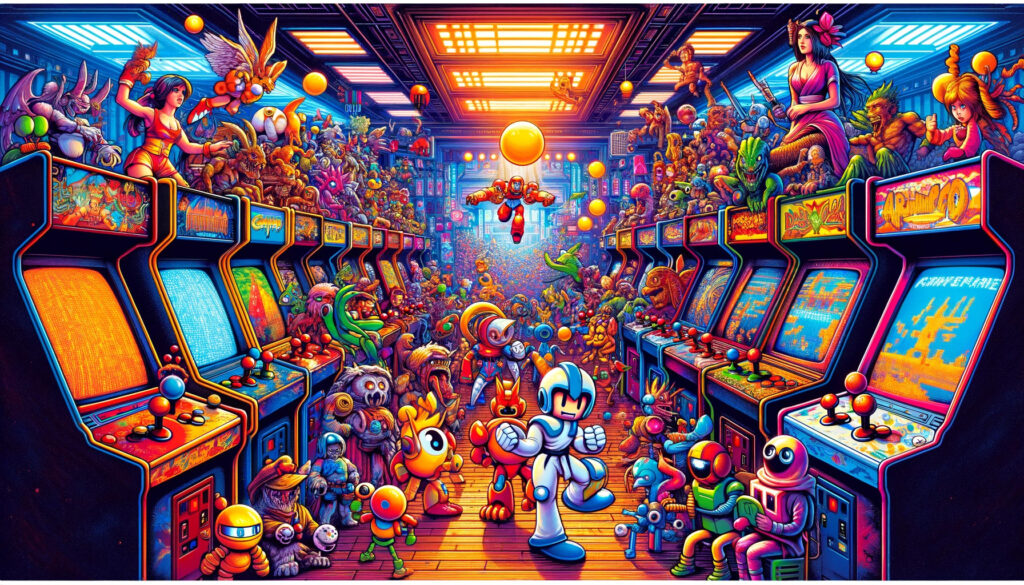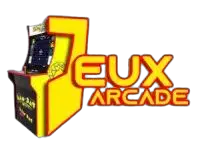
The golden age of arcades introduced us to unforgettable characters who became synonymous with the video game industry.
With their simple designs and memorable personalities, these pixelated heroes and villains captured our imaginations and fueled our competitive spirit.
Blast from the Past: Iconic Classic Arcade Game Characters
Let’s revisit some of the most iconic classic arcade game characters that still hold a special place in our gaming hearts:
1. Pac-Man (1980): This yellow, pellet-chomping icon needs no introduction. Pac-Man’s simple design and addictive gameplay made him a global phenomenon, inspiring countless merchandise and cementing his place as one of the most recognizable video game characters ever created.
2. Donkey Kong (1981): The original antagonist who kidnapped Pauline, Donkey Kong’s mischievous antics and iconic jump have left a lasting impression. This ape paved the way for Mario’s rise to fame and remains a beloved character within the Nintendo universe.
3. Mario (1981): Initially known as Jumpman, this Italian plumber has become the face of gaming. Mario’s versatility and enduring charm have made him a timeless icon, from rescuing princesses to kart racing.
4. Ms. Pac-Man (1982): The female counterpart to Pac-Man, Ms. Pac-Man added a new twist to the classic gameplay with her vibrant pink bow and slightly faster speed. Her popularity cemented her as a powerful female character in the gaming world.
5. Q*bert (1982): This little orange guy hopped his way into our hearts as he navigated a pyramid of cubes, changing their colours and avoiding enemies. Q*bert’s unique gameplay and quirky personality made him a memorable character of the early 80s.
6. Ryu (1987): From the iconic Street Fighter series, Ryu embodies the spirit of martial arts. His Hadouken and Shoryuken special moves became staples of fighting games, and his stoic demeanour and unwavering determination made him a fan favourite.
7. Chun-Li (1991): Breaking gender stereotypes in the fighting game genre, Chun-Li’s powerful kicks and lightning-fast speed made her a formidable opponent. Her athletic prowess and determined spirit inspired countless young girls to explore the world of video games.
8. Sonic the Hedgehog (1991): This blue blur redefined the platforming genre with his incredible speed and iconic spiky hair. Sonic’s carefree attitude and competitive spirit resonated with players of all ages, making him a major rival to Mario in the console wars.
9. Mortal Kombat Characters (1992): From the blood-soaked battles to iconic characters like Scorpion and Sub-Zero, Mortal Kombat pushed boundaries and redefined fighting games. Its mature themes and brutal finishing moves became synonymous with the series, making it a controversial yet popular phenomenon.
10. Crash Bandicoot (1996): This goofy marsupial with a penchant for spinning brought a new level of humour and charm to the platforming genre. Crash’s wacky antics and colourful world made him a beloved character, especially among younger gamers.
![]()
These classic arcade game characters represent just a small fraction of the iconic figures that shaped the early days of gaming. Their simple designs, memorable personalities, and engaging gameplay continue to inspire generations of gamers and developers. Even today, these characters hold a special place in our hearts, reminding us of the joy and excitement we experienced when we first entered the world of video games.
Classic Arcade Game Character FAQs
Q: How did these classic arcade game characters achieve such iconic status?
Several factors contributed to the enduring popularity of these characters:
- Simple and memorable designs: Their pixelated appearances were instantly recognizable and easily remembered, even with limited graphical capabilities.
- Engaging gameplay: Players formed strong connections with characters who mirrored their skills and challenges within the games.
- Universal themes: These characters often embodied relatable values like courage, determination, and perseverance, resonating with players from all backgrounds.
- Marketing and merchandising: Strong marketing campaigns and widespread merchandise helped solidify these characters’ presence in popular culture.
- Cultural impact: Many characters became cultural icons, appearing in movies, cartoons, and other forms of media.
Q: How have these classic characters evolved over time?
Many classic arcade game characters have undergone significant transformations over the years:
- Visual upgrades: With advancements in technology, characters’ appearances have become more detailed and realistic.
- Expanded backstories and personalities: Developers have fleshed out characters’ personalities and narratives, adding depth and complexity to their identities.
- Crossovers and collaborations: Some characters have transcended their original games, appearing in other franchises and media platforms.
- Modern interpretations: Newer games often reimagine classic characters for contemporary audiences, while still retaining their core essence.
Q: Are there any challenges in adapting classic characters to modern audiences?
Balancing nostalgia with modern expectations can be challenging when adapting classic characters. Developers must:
- Maintain the essence of the original character: While updating visuals and gameplay, the core character traits and spirit should remain intact.
- Appeal to new audiences: Modern games need to cater to contemporary players’ preferences while still engaging longtime fans.
- Address outdated elements: Sensitive topics or offensive content might need revision or removal to align with modern sensibilities.
Q: What is the future of classic arcade game characters?
These characters will likely continue to evolve and find new ways to engage audiences:
- Remakes and sequels: Classic games can be remade or reimagined for modern platforms, offering new experiences for existing and new players.
- Virtual reality and augmented reality: These technologies offer exciting opportunities for immersive experiences featuring classic characters.
- Crossover games and collaborations: Bringing together beloved characters from different franchises can create fresh and engaging experiences.
- Educational and interactive applications: Classic characters can be used in educational games and interactive experiences to engage younger generations.
The classic arcade game characters that we know and love are more than just pixels on a screen. They represent our shared history, passion for gaming, and the enduring power of creative storytelling. Their legacy continues to inspire new generations of players and developers, ensuring that these iconic figures remain etched in the hearts of gamers forever.
